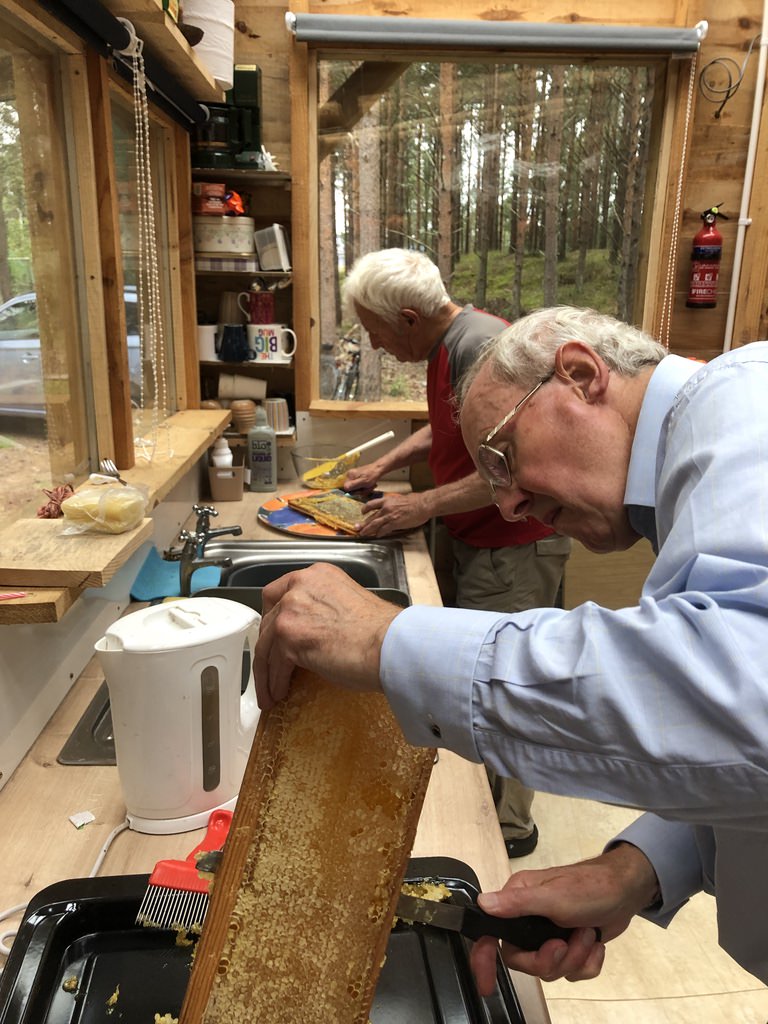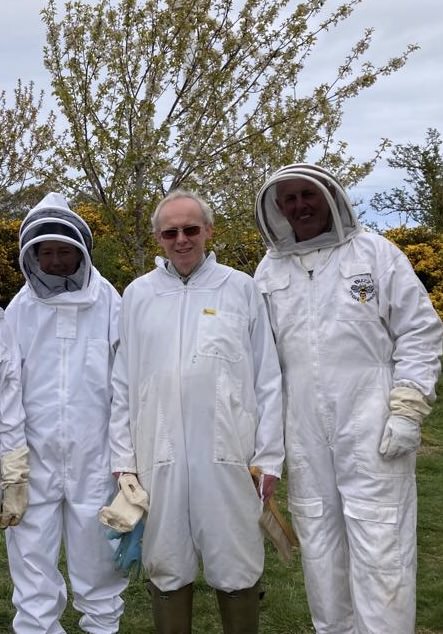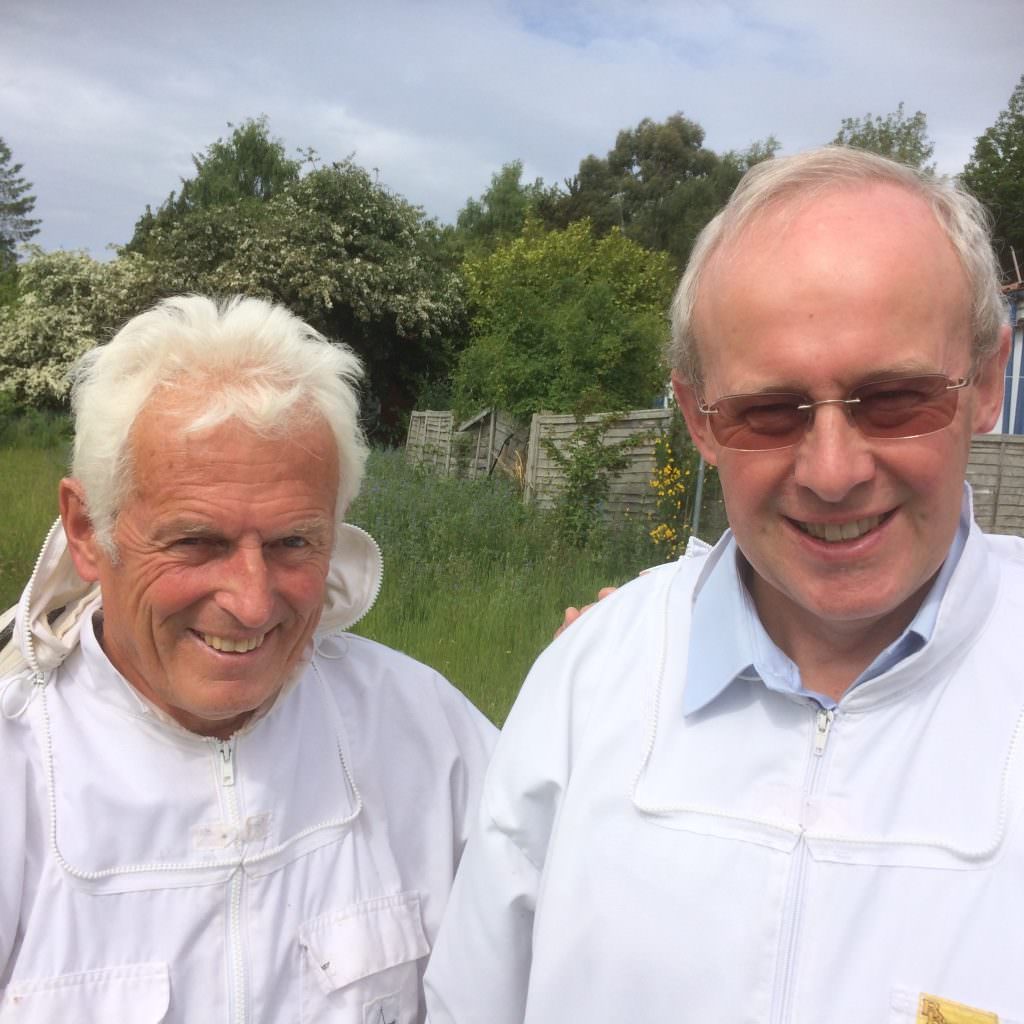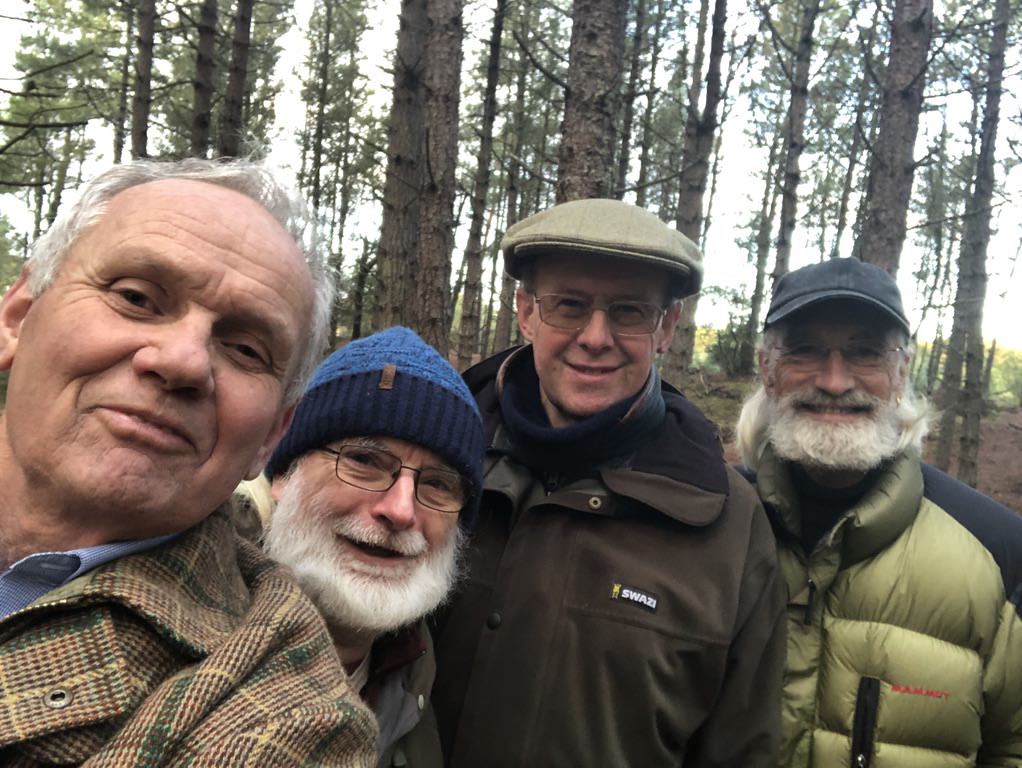Martin lives locally with his wife Elizabeth near Brodie and has been involved with the work of the FHT for at least the last six years both as part of the Land Management subgroup and as a key player as one of the three main managers of the FHT apiary. In June of this year he stepped down from his role as a very efficient and effective Secretary of the Land Management group to spend more time with his wife. Although he will carry on with the bees which he is passionate about, we thought it would be the perfect time to find out more about this quiet, knowledgeable man who has contributed so much to the work of the trust over the past few years as part of the team.

Honey Harvest
What inspired your love of Nature?
My father worked in the Forestry Commission based initially in Cambridge and the surrounding countryside so through him and his work there was always a connection to the outdoors. My mother also had an influence as she thought it might be enjoyable to work for the National Trust -this stuck at the back of my mind. Another influence on my thinking was the reading of Rachel Carson’s Silent Spring at school and this led me to getting involved in the school’s natural history society which included an annual meeting of the different societies in the Natural History Museum in London. At one of these a student gave a presentation on liverworts and talking to him afterwards he said one of the good things about studying liverworts was that most people do not know much about them and you soon become an expert. That sounded good to me and as we had moved to Cornwall by then and were surrounded by lichen’s I decided to study them resulting in two years later it being me lecturing in the Natural History Museum on these beautiful living things. I have continued to develop this joy of seeing and appreciating the small things on the land – their tiny detail, colour, structure and form. This micro world totally fascinates me – the small, beautiful and detailed living forms that are such an integral part of nature and that I see now captured so magnificently in for example Alan Watson Featherstone’s photography. This love of nature led me to choose to pursue a university degree in Land Management.
What sort of work were you involved in during your working life?
I worked as a land manager for a number of small estates coordinating all the different professions – lawyers, accountants, insurers, those dealing with the finance, farm consultants, foresters, farmers, the workforce on the estate, the building department, gamekeepers, gardeners… Helping all these to work together was a pleasant but sometimes challenging task. I was also responsible for the housing of over 200 families so there was a great sense of responsibility and obligation to get the balance between humanity and commerciality right. In addition, I was involved with over 50 farm businesses including a national company wishing to set up a green burial operation which was I guess how I heard about the Findhorn Hinterland Trust when we finally moved up to Moray.

Bee Work Party
Tell us more about why you decided to get involved in the work of the trust and how you have been able to contribute.
Judith Berry, who was part of the FHT green burial team at the time, showed us around and talked to my wife and I about the green burial site. I had been retired for a couple of years and was looking for some way of using my land management skills when I had a conversation with you as Chair of the trust. At the time you were needing some extra support on the administration side of things and were seeing the need to have a small group to progress more discussion around the important land management aspect of the trust’s work rather than simply left to decisions made by yourself or Kajedo as the Land Manager. It was back in 2017 and with my help we set up the FHT Land Management subgroup to help with coordination and implementation by bringing some structure to the land management through regular meetings with good record keeping as part of the organisation growing up. It was great that we could bring in other people like Alan and George and later Draeyk with such a diverse range of abilities, interests and speciality skills – everyone bringing something different.
And then of course there were the bees. The senior partner for the firm I worked for in England was a beekeeper and he would bring in honey to share every time he visited us. From this I became aware of something that might be of interest to me that I could do. One day in 2013 some beekeepers asked if there was a place that they could put their hives on the estate. I said I had an orchard adjoining my garden and asked them if that would do? Even though they did not take up the offer they gave me a hive to start me off and that is what got me into beekeeping. I bought all the kit and brought all of it up with me when we moved to Moray. I had the hives at home for about a year but unfortunately Elizabeth became allergic to bees and that is when I phoned you up in a panic back in 2017 to ask if my hives could become part of the FHT apiary. Beekeeping has become an absolute passion of mine and it is so good to be able to do it with others managing the FHT apiary.
What aspects have you found most satisfying with regards to the FHT work that you have been involved in?
Being able to use my experience of land management and see the land management subgroup develop into a good functional group with progress being made and things evolving over the years. To be able to assist in the administration of it and seeing it really making progress has been most satisfying.
With the bees it is having an audience – being able to talk about them and share knowledge. I particularly liked when we had one of our work parties with about fifteen people turning up and whilst they were all cleaning or putting frames together I was showing small groups a nearby hive and talking about bees all morning. It is also so lovely when people come and join us tending bees and we all share our knowledge and interest.
The other thing that is great is the educational aspect offered by the FHT such as the two visits from the Forres Secondary school. Seeing fifty youngsters being engaged with the land and wanting to learn about it is also very satisfying.

With fellow Bee Keeper John Willoner
What would be a high dream for the FHT if anything was possible?
If I had three wishes, the first would concern changing the physical. It is lovely to see the landscape evolving but what I would really love to see would be the land between here and the sea with far less gorse and trees and the wildness and openness restored giving a sense of discovery – going around every corner and finding something different and unusual. At the other end of the spectrum, looking at the spiritual side, the land should be a place where people feel that it is a thin place where heaven feels not far away- a place where people find tranquillity and reconciliation. On the human side I would like to see a place where people reconcile with nature, learn about nature, understand it and feel a part of it and ultimately in one hundred years time there are still people here that can enjoy it.
Interviewed by Jonathan Caddy
FHT Chair
16th August 2023

FHT Land Management Team

Meet the Team – Martin Harker
Martin lives locally with his wife Elizabeth near Brodie and has been involved with the work of the FHT for at least the last six years both as part of the Land Management subgroup and as a key player as one of the three main managers of the FHT apiary. In June of this year he stepped down from his role as a very efficient and effective Secretary of the Land Management group to spend more time with his wife. Although he will carry on with the bees which he is passionate about, we thought it would be the perfect time to find out more about this quiet, knowledgeable man who has contributed so much to the work of the trust over the past few years as part of the team.
Honey Harvest
What inspired your love of Nature?
My father worked in the Forestry Commission based initially in Cambridge and the surrounding countryside so through him and his work there was always a connection to the outdoors. My mother also had an influence as she thought it might be enjoyable to work for the National Trust -this stuck at the back of my mind. Another influence on my thinking was the reading of Rachel Carson’s Silent Spring at school and this led me to getting involved in the school’s natural history society which included an annual meeting of the different societies in the Natural History Museum in London. At one of these a student gave a presentation on liverworts and talking to him afterwards he said one of the good things about studying liverworts was that most people do not know much about them and you soon become an expert. That sounded good to me and as we had moved to Cornwall by then and were surrounded by lichen’s I decided to study them resulting in two years later it being me lecturing in the Natural History Museum on these beautiful living things. I have continued to develop this joy of seeing and appreciating the small things on the land – their tiny detail, colour, structure and form. This micro world totally fascinates me – the small, beautiful and detailed living forms that are such an integral part of nature and that I see now captured so magnificently in for example Alan Watson Featherstone’s photography. This love of nature led me to choose to pursue a university degree in Land Management.
What sort of work were you involved in during your working life?
I worked as a land manager for a number of small estates coordinating all the different professions – lawyers, accountants, insurers, those dealing with the finance, farm consultants, foresters, farmers, the workforce on the estate, the building department, gamekeepers, gardeners… Helping all these to work together was a pleasant but sometimes challenging task. I was also responsible for the housing of over 200 families so there was a great sense of responsibility and obligation to get the balance between humanity and commerciality right. In addition, I was involved with over 50 farm businesses including a national company wishing to set up a green burial operation which was I guess how I heard about the Findhorn Hinterland Trust when we finally moved up to Moray.
Bee Work Party
Tell us more about why you decided to get involved in the work of the trust and how you have been able to contribute.
Judith Berry, who was part of the FHT green burial team at the time, showed us around and talked to my wife and I about the green burial site. I had been retired for a couple of years and was looking for some way of using my land management skills when I had a conversation with you as Chair of the trust. At the time you were needing some extra support on the administration side of things and were seeing the need to have a small group to progress more discussion around the important land management aspect of the trust’s work rather than simply left to decisions made by yourself or Kajedo as the Land Manager. It was back in 2017 and with my help we set up the FHT Land Management subgroup to help with coordination and implementation by bringing some structure to the land management through regular meetings with good record keeping as part of the organisation growing up. It was great that we could bring in other people like Alan and George and later Draeyk with such a diverse range of abilities, interests and speciality skills – everyone bringing something different.
And then of course there were the bees. The senior partner for the firm I worked for in England was a beekeeper and he would bring in honey to share every time he visited us. From this I became aware of something that might be of interest to me that I could do. One day in 2013 some beekeepers asked if there was a place that they could put their hives on the estate. I said I had an orchard adjoining my garden and asked them if that would do? Even though they did not take up the offer they gave me a hive to start me off and that is what got me into beekeeping. I bought all the kit and brought all of it up with me when we moved to Moray. I had the hives at home for about a year but unfortunately Elizabeth became allergic to bees and that is when I phoned you up in a panic back in 2017 to ask if my hives could become part of the FHT apiary. Beekeeping has become an absolute passion of mine and it is so good to be able to do it with others managing the FHT apiary.
What aspects have you found most satisfying with regards to the FHT work that you have been involved in?
Being able to use my experience of land management and see the land management subgroup develop into a good functional group with progress being made and things evolving over the years. To be able to assist in the administration of it and seeing it really making progress has been most satisfying.
With the bees it is having an audience – being able to talk about them and share knowledge. I particularly liked when we had one of our work parties with about fifteen people turning up and whilst they were all cleaning or putting frames together I was showing small groups a nearby hive and talking about bees all morning. It is also so lovely when people come and join us tending bees and we all share our knowledge and interest.
The other thing that is great is the educational aspect offered by the FHT such as the two visits from the Forres Secondary school. Seeing fifty youngsters being engaged with the land and wanting to learn about it is also very satisfying.
With fellow Bee Keeper John Willoner
What would be a high dream for the FHT if anything was possible?
If I had three wishes, the first would concern changing the physical. It is lovely to see the landscape evolving but what I would really love to see would be the land between here and the sea with far less gorse and trees and the wildness and openness restored giving a sense of discovery – going around every corner and finding something different and unusual. At the other end of the spectrum, looking at the spiritual side, the land should be a place where people feel that it is a thin place where heaven feels not far away- a place where people find tranquillity and reconciliation. On the human side I would like to see a place where people reconcile with nature, learn about nature, understand it and feel a part of it and ultimately in one hundred years time there are still people here that can enjoy it.
Interviewed by Jonathan Caddy
FHT Chair
16th August 2023
FHT Land Management Team